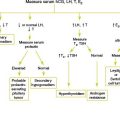Chapter 39 SEIZURES
Medications and Toxins Associated with Seizures
Anticonvulsants (from withdrawal)
Causes of Seizures
Neurologic, Congenital, or Developmental
• Benign partial epilepsy of childhood
• Degenerative cerebral disease
• Hypoxic-ischemic encephalopathy
• Infantile spasms (West’s syndrome)
Key Historical Features
 Events immediately before the onset of the episode
Events immediately before the onset of the episode
 Thorough description of the seizure
Thorough description of the seizure
 History of seizure disorder, including:
History of seizure disorder, including:
 Birth history and perinatal complications
Birth history and perinatal complications
 Cognitive behavioral history, especially:
Cognitive behavioral history, especially:
 Family history, especially family history of seizures
Family history, especially family history of seizures
Key Physical Findings
 Vital signs, including temperature, heart rate, and blood pressure
Vital signs, including temperature, heart rate, and blood pressure
 Measurement of head circumference in infants
Measurement of head circumference in infants
 General evaluation for toxic appearance or pallor
General evaluation for toxic appearance or pallor
 Head examination for dysmorphic features, syndromic facies, signs of trauma, a bulging fontanelle, or the presence of a ventriculoperitoneal shunt
Head examination for dysmorphic features, syndromic facies, signs of trauma, a bulging fontanelle, or the presence of a ventriculoperitoneal shunt
 Eye examination for papilledema or retinal hemorrhages
Eye examination for papilledema or retinal hemorrhages
 Ear examination for hemotympanum
Ear examination for hemotympanum
 Neck examination for signs of meningeal irritation
Neck examination for signs of meningeal irritation
 Abdominal examination for hepatosplenomegaly
Abdominal examination for hepatosplenomegaly
 Skin examination for petechial rash, unexplained bruising, café-au-lait spots (neurofibromatosis), adenoma sebaceum or ash leaf spots (tuberous sclerosis), or port wine stains (Sturge-Weber syndrome)
Skin examination for petechial rash, unexplained bruising, café-au-lait spots (neurofibromatosis), adenoma sebaceum or ash leaf spots (tuberous sclerosis), or port wine stains (Sturge-Weber syndrome)
 Thorough neurologic examination for focal or lateralizing deficits
Thorough neurologic examination for focal or lateralizing deficits
Suggested Work-up of Pediatric Seizures
| Bedside glucose test | To evaluate for hypoglycemia |
| Specific drug level(s) | Should be obtained in patients who are taking anticonvulsant medications |
| Electrolytes, calcium, magnesium | Indicated in patients with a history of diabetes or metabolic disorder, dehydration, excess free water intake, prolonged seizure, an altered level of consciousness, and those younger than 6 months because of an increased risk of electrolyte disturbances |
| Complete blood count (CBC) | If an infectious cause of the seizure is suspected |
| Toxicology screen | If toxin exposure is suspected |
| Lumbar puncture | Should be considered in patients with meningeal signs, altered mental status, a prolonged postictal period, a petechial rash, or in neonatal seizures |
| Brain computed tomography (CT) | Should be performed in patients with: |
Additional Work-up of Pediatric Seizures
| Blood amino acids, lactate, pyruvate, ammonia, and urine organic acids | If an inborn error of metabolism is suspected |
| Emergent EEG | For patients in whom the diagnosis of nonconvulsive status epilepticus is suspected or in those with refractory seizure activity |
| Magnetic resonance imaging (MRI) | More sensitive than a cranial CT scan for the detection of certain tumors and vascular malformations |
| HIV test | If HIV infection is suspected |
Suggested Work-up of Neonatal Seizures
1. Blumstein M.D. Childhood seizures. Emerg Med Clin North Am. 2007;25(4):1061–1086.
2. Burkhard P.R., Burkhardt K., Haenggeli C.A., Landis T. Plant-induced seizures: reappearance of an old problem. J Neurol. 1999;246:667–670.
3. Datta A., Sinclair D.B. Benign epilepsy of childhood with rolandic spikes: typical and atypical variants. Pediatr Neurol. 2007;36(3):141–145.
4. Friedman M.J., Sharieff G.Q. Seizures in children. Pediatr Clin North Am. 2006;53(2):257–277.
5. Froberg B., Ibrahim D., Furbee R.B. Plant poisoning. Emerg Med Clin North Am. 2007;25(2):375–433.
6. Wills B., Erickson T. Chemically induced seizures. Clin Lab Med. 2006;26(1):185–209.



















